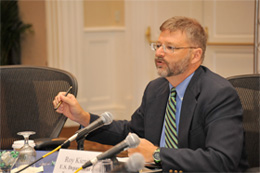Before President Obama made his call for infrastructure investment in the State of the Union address last night, an impressive panel of about a dozen DOT officials addressed the Transportation Research Board’s annual meeting to divulge what they could about the reauthorization of the long-term national transportation law.

Secretary Ray LaHood has said he’s confident we’ll have a transportation bill by August, and Rep. John Mica (R-FL), chair of the House Transportation Committee responsible for moving the bill, seems to agree with that timeline.
The current extension expires March 4, so expect yet another extension. Mica has said that he’s prioritizing the Federal Aviation Administration reauthorization above the surface transportation bill (the FAA has been stuck in an even more interminable cycle of extensions than SAFETEA-LU – 17 and counting). But Mica is hoping to get it moving before the August recess because, as one trucking industry lobbyist told the Journal of Commerce, “once we get past August, we start getting into a presidential cycle."
Roy Kienitz, undersecretary for policy at U.S. DOT, outlined six themes for the TRB audience that the development of a new transportation bill will center around (all category names are straight from Kienitz):
- Modal silos vs. multimodalism. “One of our original TIGER Grants was the Moynihan station reconstruction project in New York,” Kienitz said. “In looking into it, we found they had FRA money, they had FTA money, they had a Federal Highway Administration earmark, and we were about to give them a TIGER grant. And, of course, they had separate cooperative agreements with each one of our agencies to administer each one of the grants and we were about to write a fourth one. So, one of the principles of multimodalism is, you shouldn’t have to have four cooperative agreements with the United States Department of Transportation in order to implement one project.”
- Fewer vs. more methods of assistance. Federal transportation funding used to be simpler: There was formula money distributed to states and other public entities, and there were earmarks secured by individual lawmakers. Now there’s a whole alphabet soup of grants and loans and credit assistance programs. U.S. DOT wants to broaden some of the new programs like TIGER and somewhat older ones like TIFIA, and they want to create new ones, like that National Infrastructure Bank, which, more and more, everyone talks about like it’s a done deal.
- More vs. fewer recipients. They also want to widen the pool of recipients to include freight railroads, local governments and more. He says there’s a lot of pent-up demand among entities that have historically been excluded from these funds.
- Planning vs. box-checking. Instead of the rote process that transportation agencies currently go through to receive federal funding -- “Did you consider the environment? Yes, I considered it; check. Did you consider the impact on low-income communities? Yes, I considered it; check.” -- Kienitz said he’d rather figure out real, measurable outcomes and attach serious evaluation mechanisms to them.
- Certainty vs. competition. Sure, everybody likes knowing a big pot of money is rolling their way without them having to do much for it. But Kienitz wants states and metros to have to hustle a little bit for federal dollars. He says the tradition of maintaining strict amounts stems from the insistence on the part of members of Congress that their state or district get exactly what was in the bill they voted for, and not a penny less. But with resources as scarce as they are, the administration needs to pick innovative projects that will deliver the biggest bang for the buck.
- Not enough vs. enough money. (These are his categories, folks, not mine.) Kienitz talked about financing mostly in the context of improving project delivery. Why does it take so long to complete a project? “Step one is always: go to the end of the line,” Kienitz said. “And it’s a long line!” Then you have to pay the engineering consultants for seven years, even though they could do the job in two or three, just because it’s going to take that long to finish the project.
All right, you ask, but how’s this all going to work? Is the administration going to set guidelines for Congress to work from, as it has with other top legislative priorities, or will it actually submit a draft bill this time? Will they maintain the 80/20 split for highways and transit, with a one percent sliver cut from the "highway" portion for bike/pedestrian facilities? Will they ensure that TIGER is included in the authorization this time?
Well I asked too. And this was the answer:
“If I told you, I’d have to kill you. And then they’d kill me. So the answer is, 'Stay tuned.' Sorry.”
We’ll keep asking, dear reader. Even if it gets us killed.





